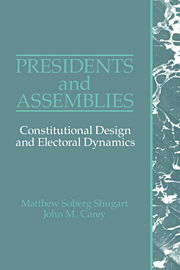Book contents
- Frontmatter
- Contents
- List of tables and figures
- Acknowledgments
- 1 Basic choices in democratic regime types
- 2 Defining regimes with elected presidents
- 3 Criticisms of presidentialism and responses
- 4 The premier-presidential and president-parliamentary experiences
- 5 The constitutional origins of chief executives
- 6 Constitutional limits on separate origin and survival
- 7 Legislative powers of presidents
- 8 Assessing the powers of the presidency
- 9 Electoral dynamics: efficiency and inefficiency
- 10 Electoral rules and the party system
- 11 Electoral cycles and the party system
- 12 Electoral cycles and compatibility between president and assembly
- 13 Conclusions
- Appendix A Electoral rules for one-seat districts and coalition-building incentives
- Appendix B Theoretical explanation for models predicting number of parties in presidential systems
- Bibliography
- Index
Appendix B - Theoretical explanation for models predicting number of parties in presidential systems
Published online by Cambridge University Press: 05 June 2012
- Frontmatter
- Contents
- List of tables and figures
- Acknowledgments
- 1 Basic choices in democratic regime types
- 2 Defining regimes with elected presidents
- 3 Criticisms of presidentialism and responses
- 4 The premier-presidential and president-parliamentary experiences
- 5 The constitutional origins of chief executives
- 6 Constitutional limits on separate origin and survival
- 7 Legislative powers of presidents
- 8 Assessing the powers of the presidency
- 9 Electoral dynamics: efficiency and inefficiency
- 10 Electoral rules and the party system
- 11 Electoral cycles and the party system
- 12 Electoral cycles and compatibility between president and assembly
- 13 Conclusions
- Appendix A Electoral rules for one-seat districts and coalition-building incentives
- Appendix B Theoretical explanation for models predicting number of parties in presidential systems
- Bibliography
- Index
Summary
Our task here is to achieve models for predicting the number of parties in a political system according to various institutional features. As mentioned in Chapter 10, the most important of these features has for some time now been recognized to be district magnitude, M. Additionally, according to the reasoning regarding Duverger's rule, also discussed near the beginning of Chapter 11, presidential systems might be expected to be different from parliamentary systems in their number of parties, for a given magnitude. That this should be so, at least for those presidential systems employing concurrent elections and plurality rule for the presidency, was foreshad-owed by Table 10.2, in which nationwide values of effective number of parties (N) are given. Our task here is to go beyond the purely empirical observations of Chapter 10 and seek theoretical explanation.
This discussion builds upon Taagepera and Shugart (1992a, b), in which are developed general models of the relation between magnitude and number of parties. By general models, we mean models for the simplest of general cases, that is, primarily parliamentary systems. When we add to the PR assembly electoral system the complexity of a concurrently elected presidency using plurality rule, it is necessary to make further assumptions in the model. Some of this material has already been discussed in Chapter 11, but the discussion here is more technical.
- Type
- Chapter
- Information
- Presidents and AssembliesConstitutional Design and Electoral Dynamics, pp. 293 - 300Publisher: Cambridge University PressPrint publication year: 1992



